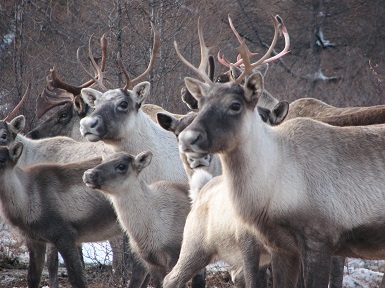Reindeer will feel effects of climate change.
 The heat is on for the world’s caribou with a new study warning the creatures could lose as much as 60 per cent of their range within 60 years.
The heat is on for the world’s caribou with a new study warning the creatures could lose as much as 60 per cent of their range within 60 years.Caribou, often called reindeer, are among the most numerous and mysterious animals in Canada, but many herds are in decline.
And while it might be fun to think they can fly with Santa, the report says there will be no escaping the rising temperatures transforming their habitat.
“The changes will be worse in North America than in Europe,” said Steeve Cote, a caribou expert at Laval University. He led the international study published Sunday in the journal Nature Climate Change.
It reveals a distinct genetic lineage of caribou found only in Canada. And it says the lineage “is likely to become increasingly fragmented, possibly disappearing from most of its present range.”
The scientists estimate 89 per cent of the “suitable area” for these caribou, which are found in Labrador, Quebec and Ontario and are a dietary mainstay for many First Nations people, could be lost within 60 years. That compares a 60 per cent loss in range predicted for the lineage that makes up the rest of the world’s caribou.
The study analyzed DNA from 1,300 caribou from across North America, Europe, Russia and Greenland. It is the most comprehensive look yet at how the animals responded to past climate change and how they ‘ll fare as temperature climb in coming decades due to the greenhouse gases being pumped into the atmosphere.
Caribou crossed the ice bridge into North America from Eurasia long ago with wooly mammoths and saber toothed cats. The genetic analysis indicates the population diverged when North America was blanketed with kilometres-thick ice sheets during the ice ages.
Caribou in eastern North America took refuge from the massive ice sheets in an area “probably just south of Quebec,” said Cote. When the ice retreated, the animals moved north, giving rise to the caribou now found in Northern Quebec and Labrador and scattered across Canada’s boreal forest.
A second refuge existed in the west, likely near the Bering Strait, said Cote. The study found the caribou in this lineage spread much further when the ice retreated, colonizing northern regions in the Canadian Arctic and across northern Asia and Europe.
As a result the caribou in Nunavut and the Northwest Territories are genetically more similar to populations in northern Europe than those in eastern Canada, Cote said in an interview: “Even populations on the other side of Hudson Bay are closer to populations from Svalbard, Norway, than they are to populations in Quebec.”
He had expected to find more genetic subgroups and was surprised to find just two lineages, with one “distinct society” restricted largely to Quebec and Labrador
It is estimated more than two million caribou roam Canada from Ellesmere Island to British Columbia, with some herds covering thousands of kilometres during their annual migrations. But biologists say many of the populations are threatened and in decline with some herds crashing.
The George River herd in Northern Quebec and Labrador has plummeted from about 800,000 animals in the 1980s to less than 20,000 today. “Things for the George River herd are going very badly,” said Cote, who heads a research group trying to find out why. Habitat degradation, large predator populations, disease and overhunting are likely all contributing, he said.
Cote has called for an end to hunting of the George River caribou until the herd recovers, which has been a tough sell with some aboriginal hunters. “Unfortunately they are the ones that will suffer the most,” he said, noting the cultural and dietary importance of caribou to First Nations communities.
Mining , logging and oil and gas activities are also degrading caribou habitat across Canada. And climate change is a huge threat, with Cote and his colleagues predicting the distribution of caribou will “become more restricted to high latitudes than today, with possible extirpations in the southernmost regions.”
The study says the range of the distinct Canadian caribou lineage could shrink 89 per cent by 2070 and the range for other the lineage by 60 per cent under what the scientists call the “severe climatic warming scenario.” Cote said the severe or pessimistic scenario is also the “most realistic.”
The antlered ungulates won’t disappear but he says “the main result will probably be large decreases in population size because there will be a lot less habitat that will be suitable for them.”
Cote said the animals will have to adapt to not only warmer temperatures, but also changing precipitation patterns and growing seasons. There is already evidence form Greenland that calving and female lactation are becoming out of sync because spring “green up” now occurs earlier, he said.
You can return to the main Market News page, or press the Back button on your browser.

